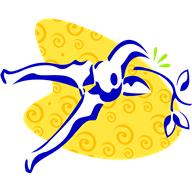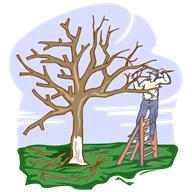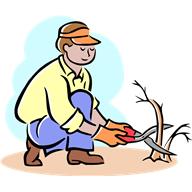|
Winter/Rejuvenation Dormant
Pruning of Trees and Shrubs
 As spring approaches, late winter is the perfect time of year to perform major corrective pruning of both trees and shrubs. Plants are pruned for different reasons. Shrub roses require pruning annually, to create new growth for future blossoms. Trees require the removal of unwanted interior or trunk sucker growth, pruning to raise their lower canopies, and pruning of canopies to thin and improve their overall canopy structure. As spring approaches, late winter is the perfect time of year to perform major corrective pruning of both trees and shrubs. Plants are pruned for different reasons. Shrub roses require pruning annually, to create new growth for future blossoms. Trees require the removal of unwanted interior or trunk sucker growth, pruning to raise their lower canopies, and pruning of canopies to thin and improve their overall canopy structure.
 All trees should be pruned now, when they are dormant and you are better able to see their structure. Ornamental grasses should have the bulk of last year's foliage cut away to allow new growth to emerge from the base of plants. All trees should be pruned now, when they are dormant and you are better able to see their structure. Ornamental grasses should have the bulk of last year's foliage cut away to allow new growth to emerge from the base of plants.
February and March are great times to prune shrubs and get them ready for the next growing season. Coming out of winter dormancy, shrubs are stimulated by the warm weather to grow rapidly. Pruning of some shrubs such as Azaleas and Forsythia might be delayed until after these plants complete their bloom cycle. Your OLM consultant will establish a specific timeline of when each plant should be pruned.
 Major rejuvenation pruning maybe necessary to shrubs such as Hollies or Ligustrum to correct the effects of over shearing, improve plant vigor, restore the natural shape and appearance of these plants, and to reduce the overall size of these plants. In many cases these plants have become ‘leggy’ as they have grown larger, the foliage above shading out the limbs below, causing them to die and drop off. If this is your situation, the best procedure is simply to hard cutback prune the entire plant down to 12 to 15 inches in height and allow the plant to start over. This may seem like a drastic move; however a shrub with a mature root system can easily recover. By summer, hard cutback prune plants will be covered with new, healthy foliage. Much of rejuvenation pruning is accomplished using hand pruners and loppers. Your OLM consultant will assist the landscape maintenance contractor with determining the proper and most efficient pruning techniques to be employed to accomplish this work. Major rejuvenation pruning maybe necessary to shrubs such as Hollies or Ligustrum to correct the effects of over shearing, improve plant vigor, restore the natural shape and appearance of these plants, and to reduce the overall size of these plants. In many cases these plants have become ‘leggy’ as they have grown larger, the foliage above shading out the limbs below, causing them to die and drop off. If this is your situation, the best procedure is simply to hard cutback prune the entire plant down to 12 to 15 inches in height and allow the plant to start over. This may seem like a drastic move; however a shrub with a mature root system can easily recover. By summer, hard cutback prune plants will be covered with new, healthy foliage. Much of rejuvenation pruning is accomplished using hand pruners and loppers. Your OLM consultant will assist the landscape maintenance contractor with determining the proper and most efficient pruning techniques to be employed to accomplish this work.
In some case, shrubs maybe pruned less severely and require only selective hand pruning cuts to thin crowded branches, remove any obvious dead wood, or reduce ‘multiple’ branch breaks created by over shearing.
 Horticultural experts agree that the use of electric and gas-powered hedge trimmers to prune shrubs is detrimental to the health and vigor of most shrubs. Repetitive shearing of shrubs results in an ‘eggshell’ exterior of green growth covering an interior of brown, leafless stems and branches. Sunlight cannot penetrate the interior of the plant, and no leaves will grow there. Shearing also further stresses shrubs making them less drought tolerant, and increases insect and disease infestations. OLM specifications require that shrubs be hand pruned rather than sheared to protect the customer's valuable landscape assets. Horticultural experts agree that the use of electric and gas-powered hedge trimmers to prune shrubs is detrimental to the health and vigor of most shrubs. Repetitive shearing of shrubs results in an ‘eggshell’ exterior of green growth covering an interior of brown, leafless stems and branches. Sunlight cannot penetrate the interior of the plant, and no leaves will grow there. Shearing also further stresses shrubs making them less drought tolerant, and increases insect and disease infestations. OLM specifications require that shrubs be hand pruned rather than sheared to protect the customer's valuable landscape assets.
|